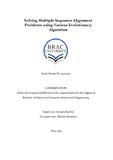| dc.description.abstract | Bioinformatics is an art and science conceptualized with the use of computational biology. This review paints a broader picture of bioinformatics, on how the sequences of DNA, RNA are organized in the right possible alignment with minimal gap between the sequences. The roles of bioinformatics are highlighted at multiple points along the path from high-tech data generation to biological discovery. Sequence Alignment is used to find the areas of sequence similarity that could point to the structure of an evolutionary ancestor or provide information about the evolutionary history of the sequences. Multiple Sequence Alignment is a way of arranging the sequences of DNA and RNA to identify regions of similarity that may be a consequence of functional, structural, or evolutionary relationships between the sequences. The work will involve study of multiple algorithms, Genetic Algorithm, Artificial Bee Colony Algorithm and Hybrid Algorithm. The proposed algorithms are implemented for solving the problem, Multiple Sequence Alignment. Result based on fitness against number of iterations graphical representation will show the best algorithm for this particular problem. However, results, similarities, differences efficiency of the implementations on these algorithms will be compared. | en_US |

